The QNAP TBS-464 NVMe SSD NAS Drive Review
The new NVMe SSD focused NAS Drive from QNAP, the TBS-464, is the first entry by the brand in their largely 2022 focused TS-x64 series and one that certainly left me a tad surprised when it was revealed. The use of SSDs in NAS servers is by no means a new thing, with several ‘flash’ produced NAS systems released over the years that focused on 2.5″ SATA/SAS or U.2 SSD in rackmount and desktop form. Likewise, the inclusion of dedicated NVMe Slots in NAS drives has now been around for around well over half a decade, either for use as cache or individual storage pools. However, combining these two concepts of NVMe SSDs and SSD only desktop NAS systems is something that has never really been done and that is what makes the QNAP TS-464 so interesting. Arriving in a spectacularly compact fashion, RAID support over 4 PCIe Gen 3 M.2 NVMe slots and an intel powered architecture, this new NASBook release has a great deal of potential to live up to for both home and business users alike. So, let’s take a good look at the TBS-464, the hardware, the software and ultimately decide if this new NVMe SSD focused NAS drive is worth your data.
QNAP TBS-464 NVMe SSD NAS Review – Quick Conclusion
The QNAP TBS-464 NVMe SSD NAS is a genuinely groundbreaking and unique piece of kit that is slightly hampered by its own price tag! Easily the most compact NAS currently available from this (and indeed almost any other) brand, it brings the majority of NAS software, services and features that buyers want in a NAS that shifts focus to SSD storage media and does it whilst maintaining an incredibly small footprint. The appeal of a RAID 5, NVMe powered NAS for your data, when the price of such media (in Gen 3 at least) becomes significantly more affordable is also a smart move. As a first physical reveal of QNAP’s planned X64 and X62 series, it hits all the right notes for me and as long as you understand that keeping this device Prosumer (whilst not tiptoeing into the enterprise) means that occasional hardware scaling is required, it’s a great piece of kit. A unique joy to play with.
QNAP TBS-464 NVMe SSD NAS Review – PACKAGING & ACCESSORIES
The first thing that hit me when I unpacked the shipping carton to get my hands on the TBS-464 is the size of the box. I was aware that this would be a small NAS, given the NVMe media choice, but the retail box is easily one of the smallest that I have received from QNAP. I was a little surprised to think that this box contained the TS-464 and accessories (will get to those later – because there is more than usual) and was a tiny bit concerned about damage in transit. Keen followers of this blog know that I will judge a brand that doesn’t protect their kit in transit quite harshly and this one might be toeing the line a bit.

Removing the outer box shows that the unit is held in a cardboard framework (the TBS-464 in plastic) and the accessories are held in a smaller compartment underneath the unit. Normally I would be quite critical of this (highlighting that hard/rigid foam be used) as shock/motion damage in transit is a greater hardware killer than most think, but I also have to factor in that the TBS-464 is very, VERY light. The unit itself only weighing in at 700grams and the complete box and accessories barely crossed the 1.5KG mark means that this level of protection in transit (unpopulated) is sufficient.
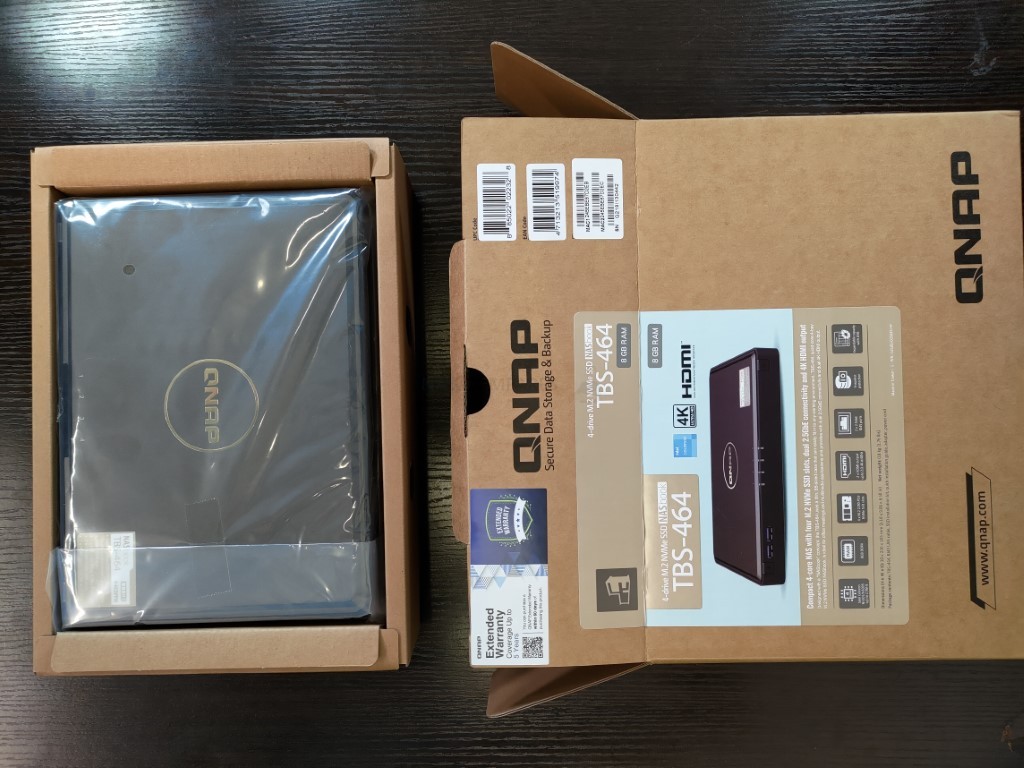
Laying out the accessories and unit on the table, there are the usual bits that you might expect (the external PSU, the mains power cable, the RJ45 Cat 5e cable, setup guide and 2yr warranty information), but there are also some dedicated M.2 NVMe extras too.
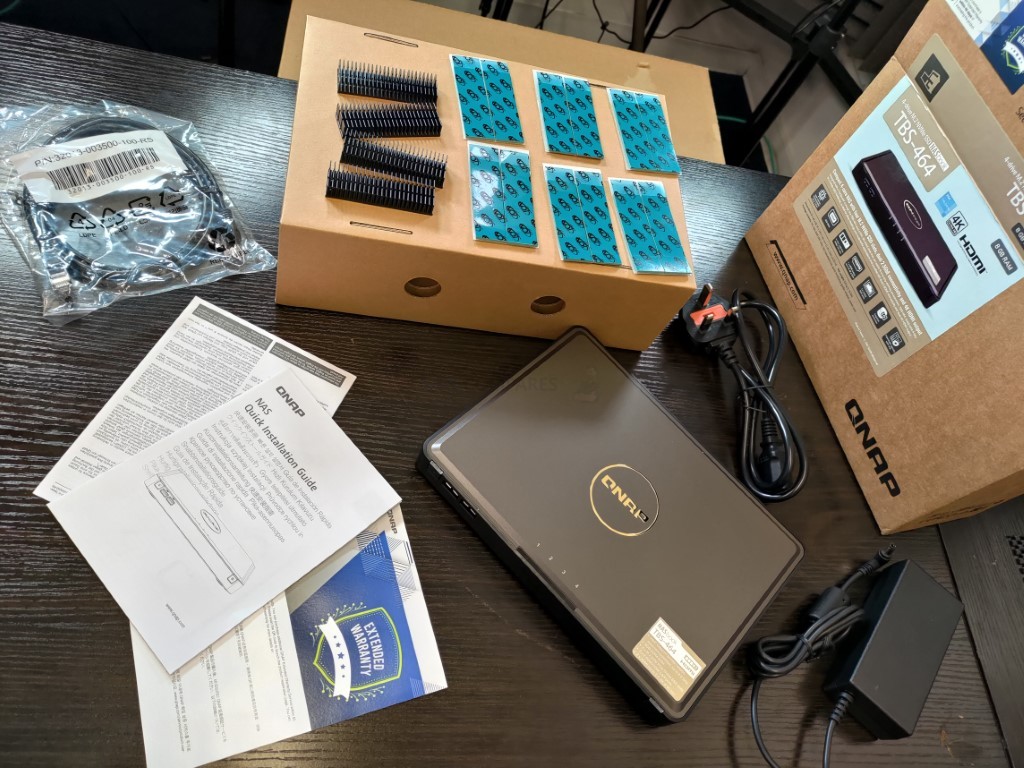
The external PSU on this rather modest-sized NAS arrives is 65W (unsurprising for much more power-efficient M.2) and QNAP state that it has been recorded at 18W power use in idle and 28W when in active use – this includes the internal fan in operation at all times.
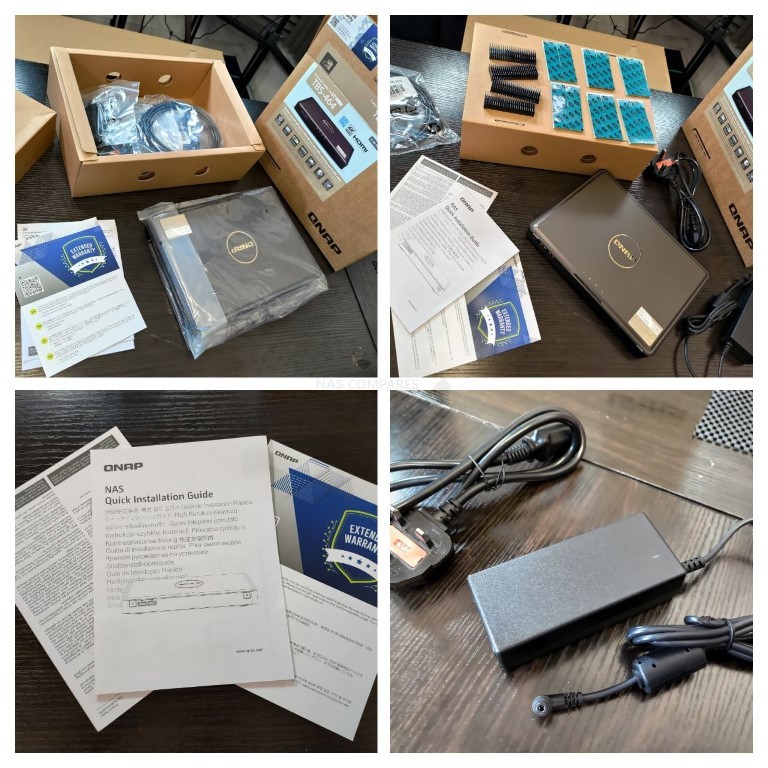
Those M.2 SSD focused accessories are also of significant importance too, with 12 thermal pads and 4 metal heatsinks that are adhesively applied to the M.2 SSDs inside. NVMe SSDs, although lacking the slower moving parts of traditional hard drives, are formed of multiple cells that are attached to a length of PCB. These consist of the Controller (the brains, like the CPU of a computer), the memory and the NAND (where your data lives), with electricity passed through the SSD to read/write data. This results in the individual chips getting quite hot. The NAND can usually operate better when its a little ‘warm’, but the controller will work worse, the hotter it gets (also known as throttling, to preserve the life of the drive) and that is why there is a lot of accessories here for dissipating the heat from these SSDs. There is an internal fan and unique cooling system (at least, for NAS) that I will touch on later, but these accessories are primarily included to draw heat AWAY from the SSDs. They are of good build quality and are a nice indicator that QNAP didn’t just shove this thing out the door.
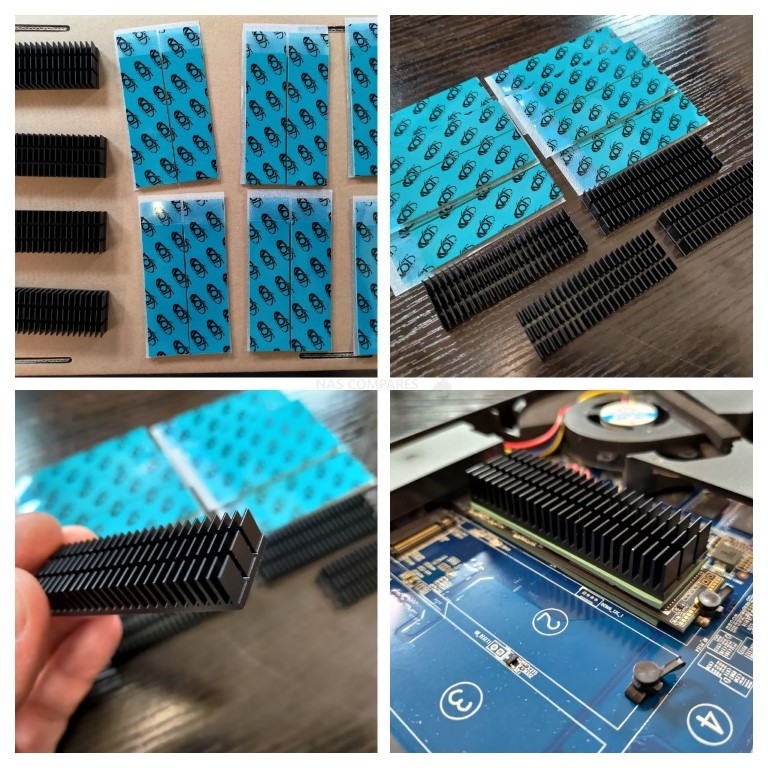
Overall, I am happy with the compact presentation and accessories, though I wonder how protected it is when shipped fully populated. Let’s take a look at the design of the QNAP TS-464 NAS.

QNAP TBS-464 NVMe SSD NAS Review – Design
As mentioned earlier, the TBS-464 is a remarkably small NAS drive. Indeed this NAS series (known as the NASBook series) has been around in different forms over the years, tough previous generations used m.2 SATA SSDs. This NAS, when deployed on the table takes up next to no room. Below is how the TBS-464 scaled up against my Google Pixel 2XL, a 2280 SSD and a pencil. Do remember that although this is a network-attached storage device, users CAN directly connect with this device point-to-point with a LAN cable, USB-to-Ethernet adapter (available in 2.5GbE and 5GbE) and even wirelessly with several USB-WiFi dongles supported. Therefore it is not impossible to imagine carrying this NAS system portable for home, school or business work, creating a portable, super fast RAID system.
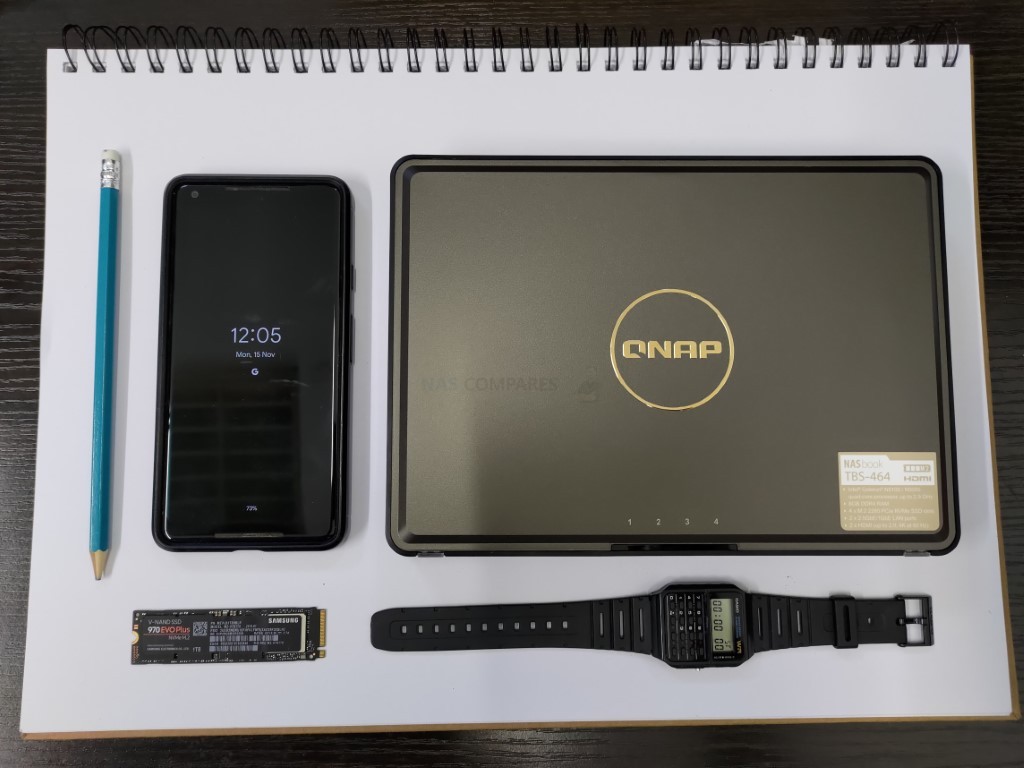
The height of the TBS-464 is also quite impressive too, at just 3cm/30mm, it is a very petite NAS indeed. The drive installation does not involve trays or any form of hot-swapping (as you might expect, as M.2 NVMe does not support that kind of re-injection), with installation involving removing the base panel to access the slots.

The front of the TBS-464 features 4 LEDs that are used to denote SSD media activity on each bay internally. Unlike traditional HDD focused NAS systems, you are not going to hear any kind of activity from the storage media (the only noise coming from that internal single fan) resulting in a very, very low ambient noise level when in use that QNAP report at 25db(A) in full access mode.
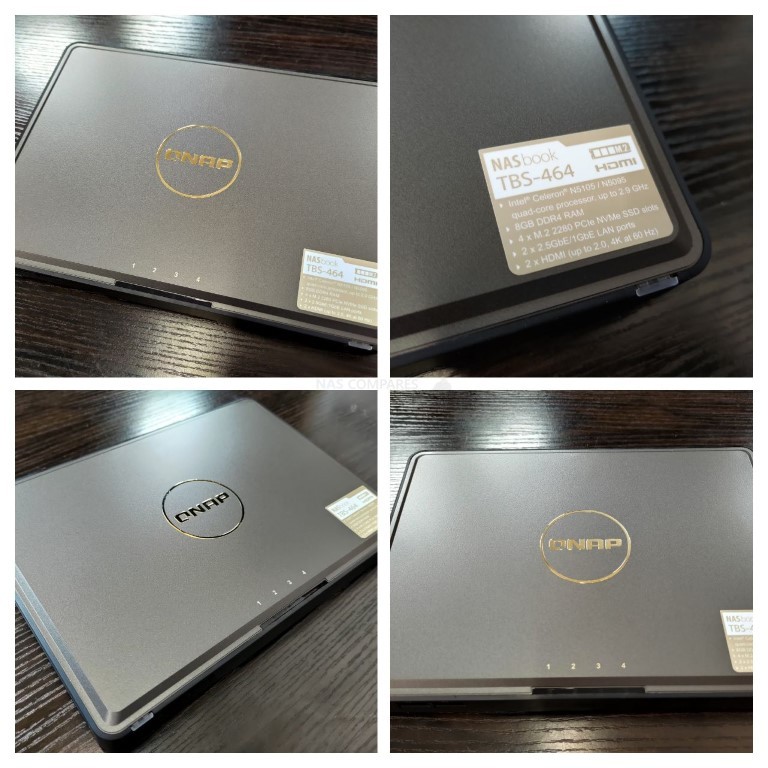
Alongside those LEDs are two USB 3.2 Gen 1 (5Gb/s) ports, as well as a 1-touch-copy button that can be used to manually action a pre-set backup routine (that you set up in Hybrid Backup Sync 3 with QTS 5). It’s a shame that this system does not take advantage of USB 3.2 Gen 2 (10Gb/s), given the wide variety of support we have seen of it on other TS-x64 devices in QNAP’s portfolio, but this is almost certainly down to those NVMe M.2 SSD slots taking up the lion share of the available PCI lanes of the CPU nad chipset.
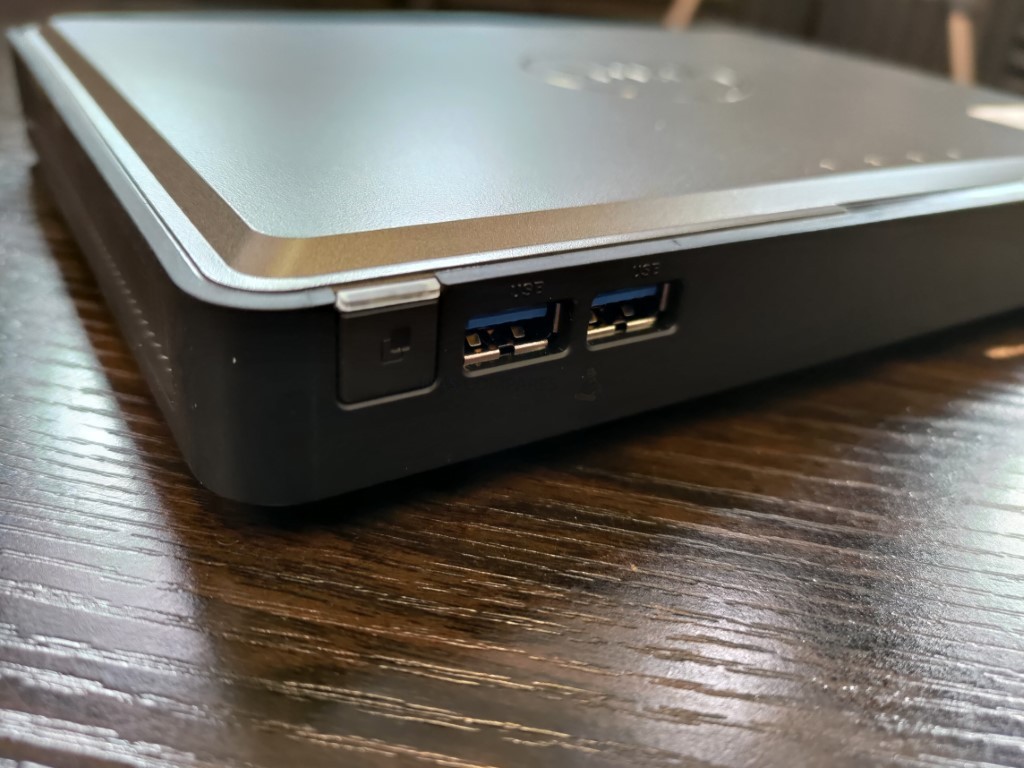
On the side of the TBS-464, next to a vent, we find an additional USB 2.0 port. More USB ports are always going to be a good thing, but aside from the support of keyboards, mice, UPS heartbeats and a few other peripherals, USB 2.0 has limited use in 2021/2022 and I am surprised that it is still here (and arguably in abundance, as you will see).
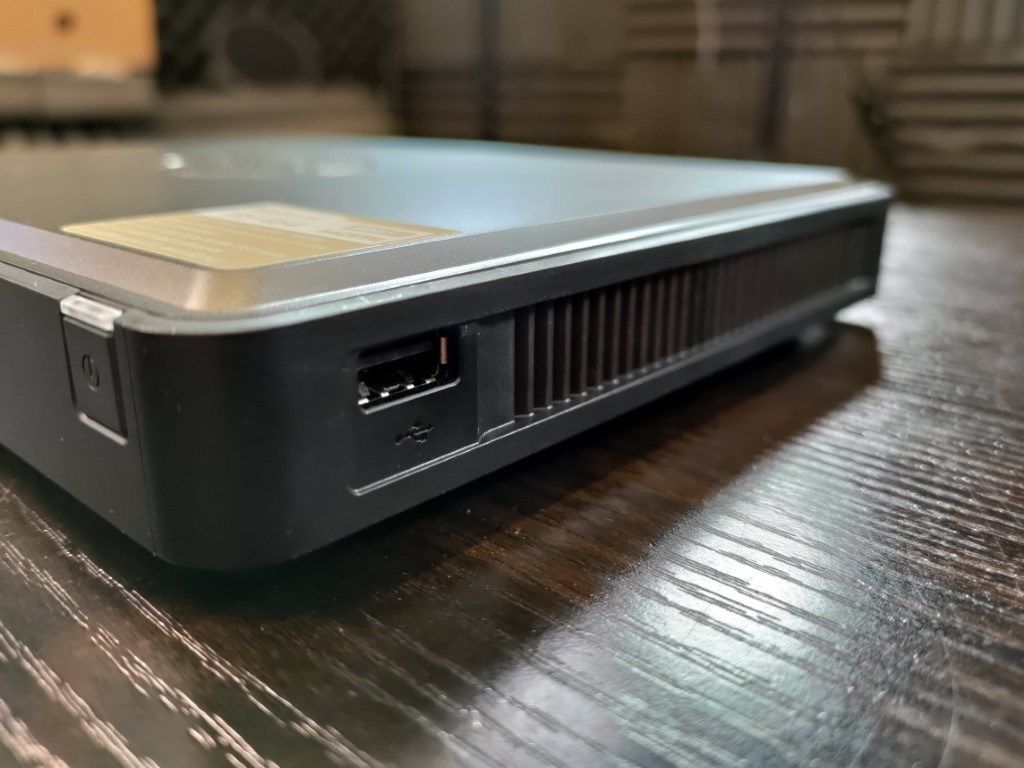
Either side of the TBS-464 chassis features a large vent panel that is used in conjunction with the internal fan to draw in and then push air throughout the NAS. This will be discussed in a little more detail in a bit, but I did want to highlight that the previous generation of this NAS family (the m.2 SATA TBS-453DX) also featured stereo speakers in these vents – a very quirky and unique extra that added to it’s localized deployment. Although its inclusion was INCREDIBLY niche and almost completely overlooked, I am still a pinch sad that it is absent in the TBS-464.
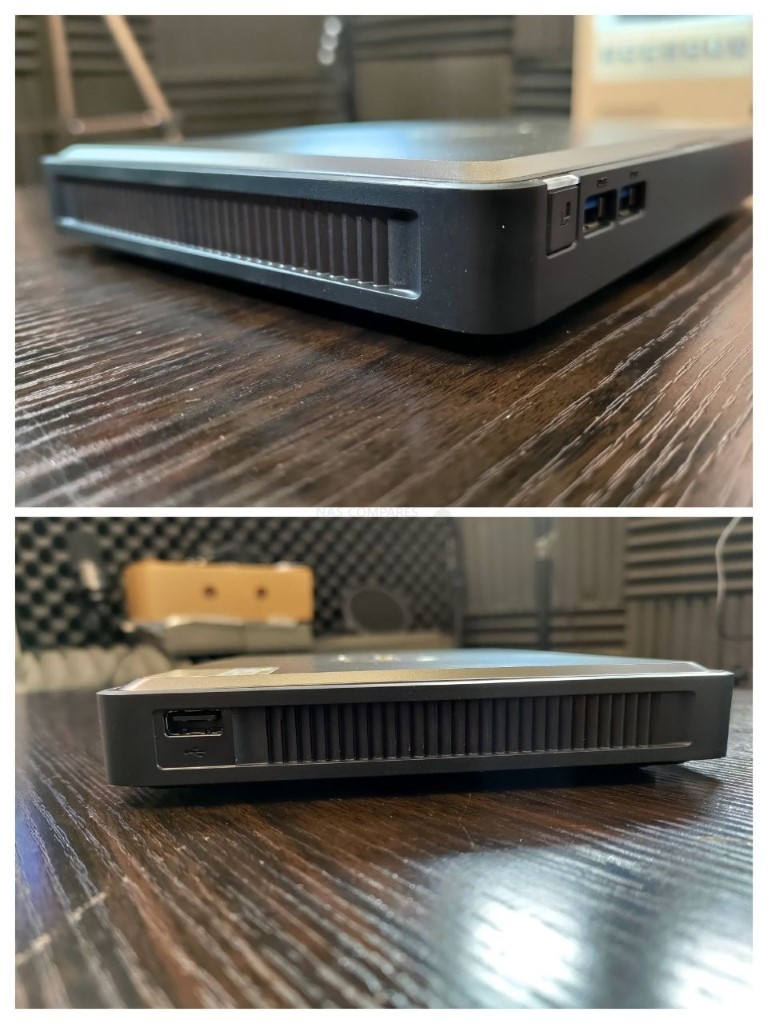
The base of the TBS-464 NAS has vent holes under each m.2 2280 storage bay, but nowhere else. This is clearly intended as a means of ensuring the airflow is controlled internally to be drawn over each of the heatsinks and chips in a single wave.
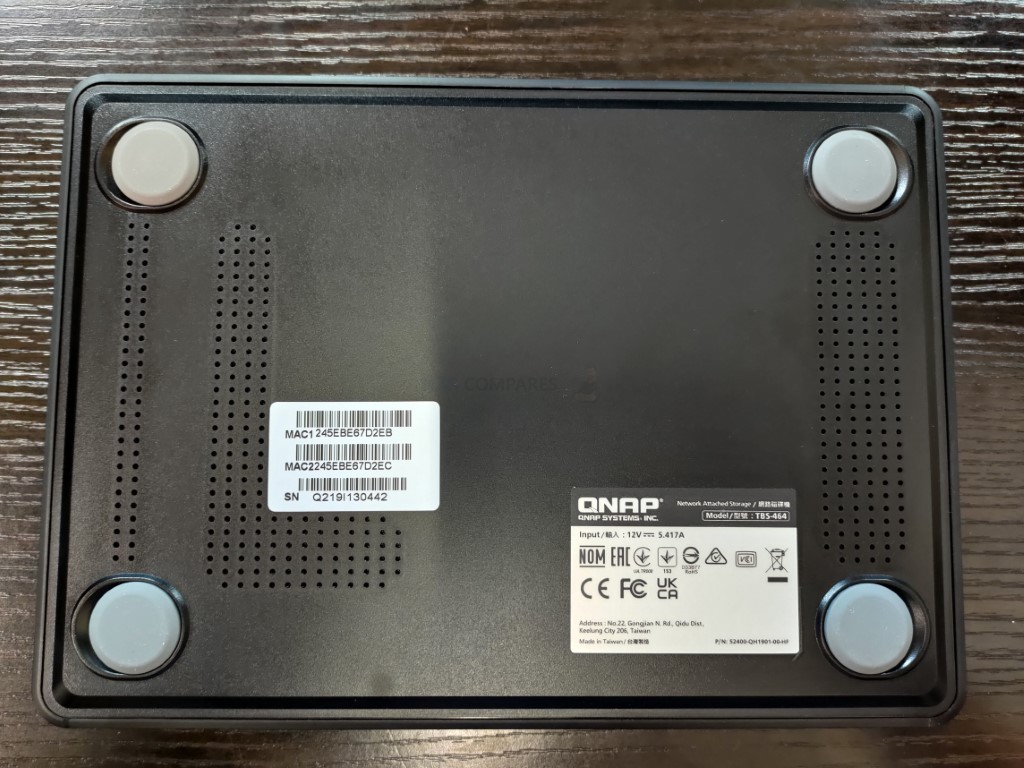
To access the storage media bays of the TBS-464, you need to remove the rubber foot on the base of the chassis as shown, to reveal an available screw. The internals of this NAS are surprisingly well crafted in terms of how things are compartmentalized. But before we get to that, let’s discuss the ports and connections.
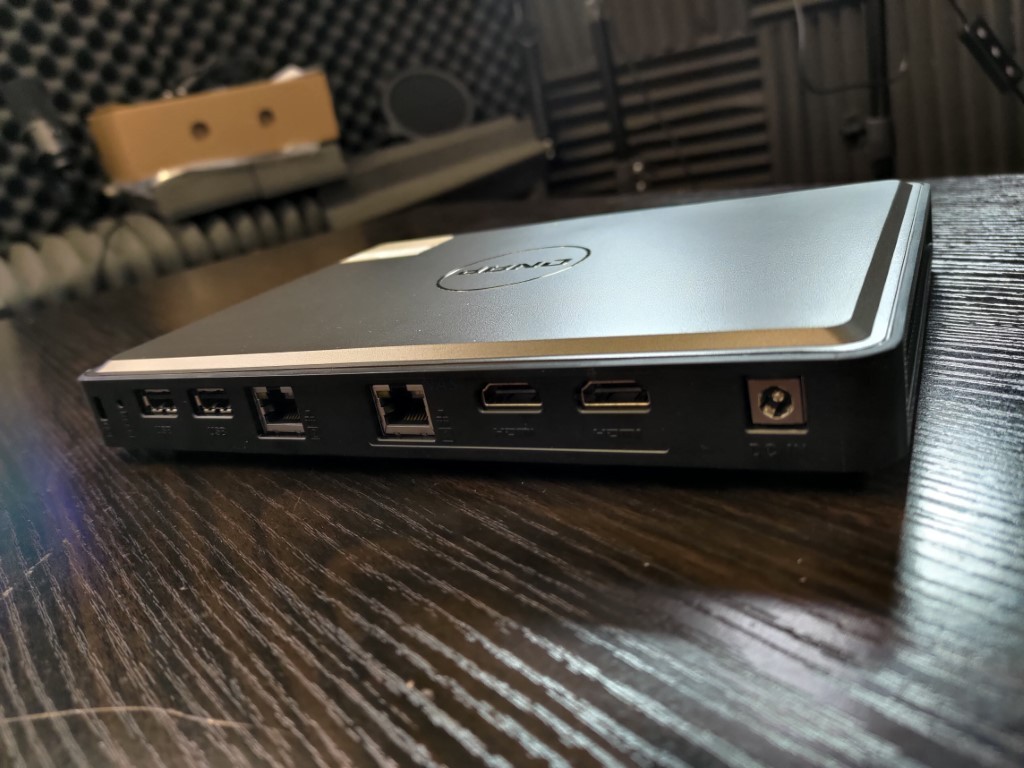
QNAP TBS-464 NVMe SSD NAS Review – Ports & Connections
Looking at the rear of the TBS-464, we can see an interesting mix of ports and connections available. The previous generation of this NAS family, the TBS-453DX released in 2018, featured an arguably more appealing 10GbE connection (made possible by only supporting SATA SSDs). The TBS-464 features 2x 2.5G connections, which might seem a bit of a step down for some, but the reality of this needs a little closer examination.
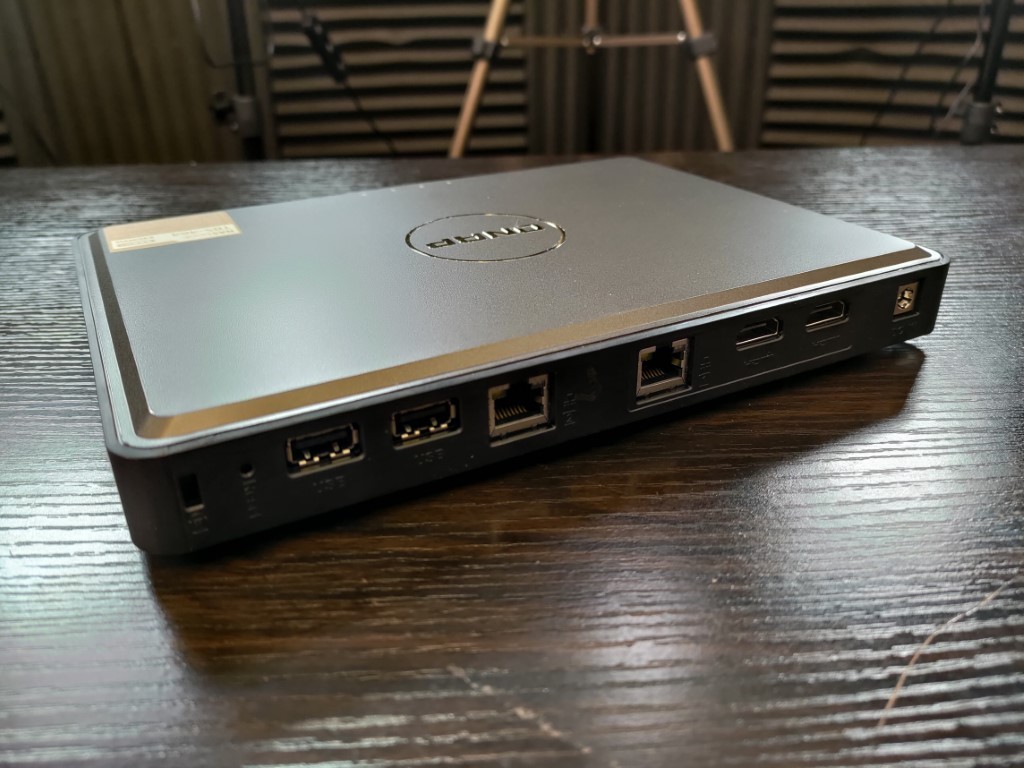
The two 2.5GbE RJ45 ports support link aggregation of course, so 5GbE connectivity via a supported managed switch is possible (as well as support of USB-to-5GbE adapters like the QNA-UC5G1T) and this allows up to 586MB/s read performance and 574MB/s write performance. Now, many might argue that this is quite a bottleneck for those internal PCIe M.2 NVMe SSDs – something we will go into more detail on later on), but such external bottlenecks of NAS are hardly new, given that most NAS hard drives these days can comfortably output 200MB/s, but are all bottlenecked to 1GbE anyway and worse still in RAID configs). I do still wish we had 10GbE on this device (even if it means removing all other ports except a single USB 3.0 port) but likely this was not possible technically anyway via the Intel Celeron inside.
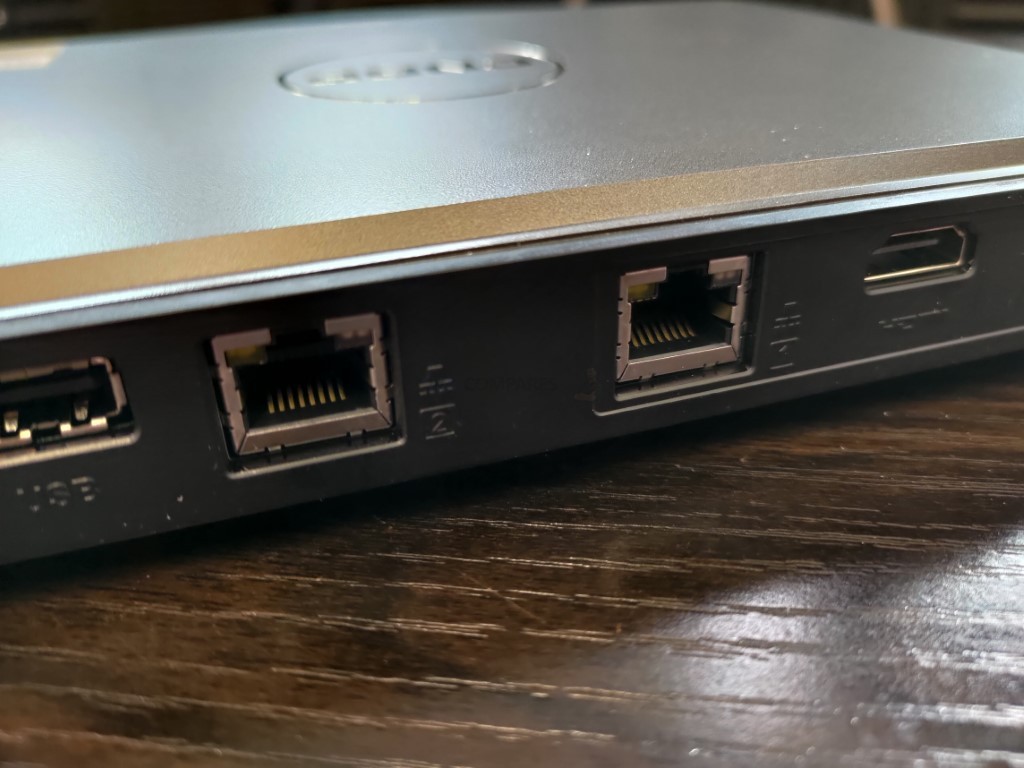
QNAP themselves have tested the performance of the TBS-464 in a RAID 5 over 4 NAS SSDs from Seagate and reached max external bandwidth of 294MB/s Upload and 287MB/s Download.
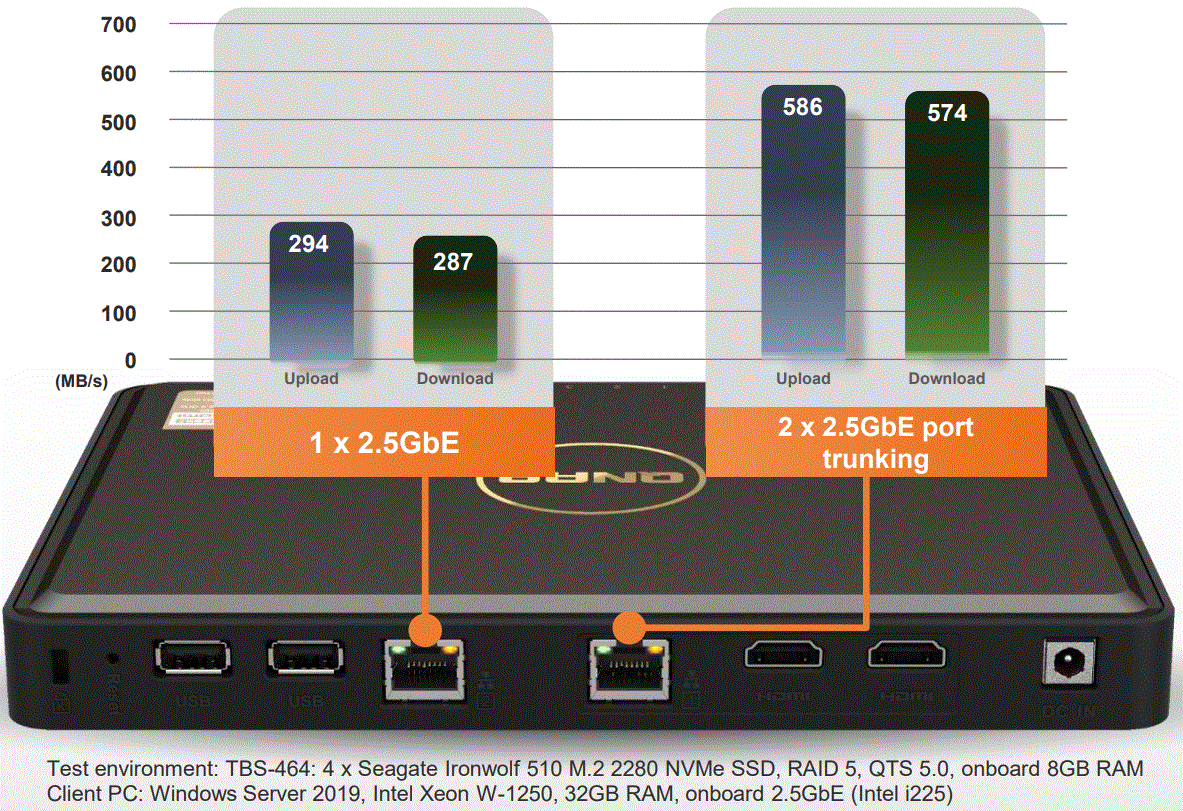
The TBS-464 also features two HDMI 2.0 video output poets. These work in conjunction with the parallel running GUI called HD Station, to allow users to interact with the NAS and many applications using an HDMI TV/Monitor, as well as connecting a keyboard and mouse (or using a Bluetooth dongle, IR remote or WiFi remote) to interact with the system. This can be used as a standalone windows PC (using QVM), a Linux PC (using Ubuntu Station), a standalone surveillance system with camera control, support of Skype, Spotify, LibreOffice, chrome, Facebook and more. There is also a large homebrew community over on QNAPClub that supports lots of existing windows and linux tools that are converted over to the QNAP platform. As good as this all sounds, it is worth remembering that these two HDMI ports cannot be used independently and are only used for mirroring each other or creating a shared-wider single screen.
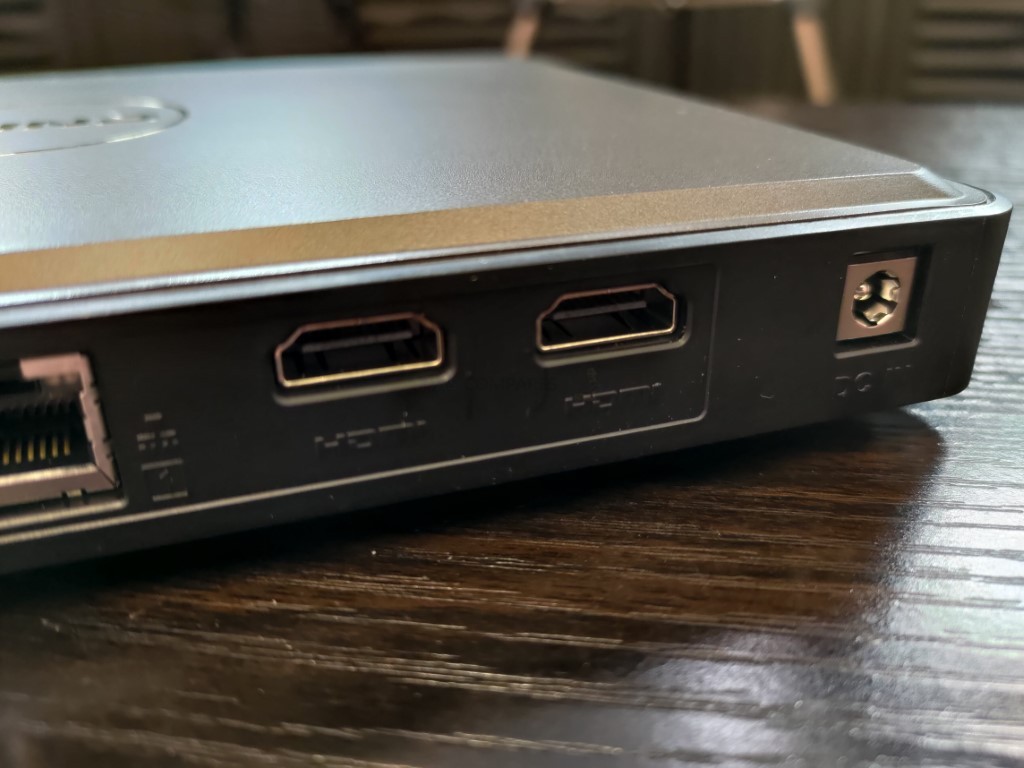
I am working on a 2021/2022 revisit of HD Station from QNAP, but below is the Setup guide and overview of the application from last year that still covers a lot of the platforms abilities and features:
One sour point on the TBS-464 that I will continue to come back to is the surprising number of USB 2.0 ports, with 2 more here on the back of the NAS chassis. I understand that this system has support of KVM for those visual ports and some connected client hardware, such as UPS’, external optical drives and Printers do not need USB 3, but given that QNAP has a large number of USB expansion devices, network adapters and supported USB devices like webcams, these ports seem a bit of old. Perhaps the chipset would not allow the swapping of these three ports in favour of a single extra USB 3 port (the truth is I do not know) but even having the USB 3 ports on the front (awkward for expansions) and the USB on the rear, seems a strange choice.
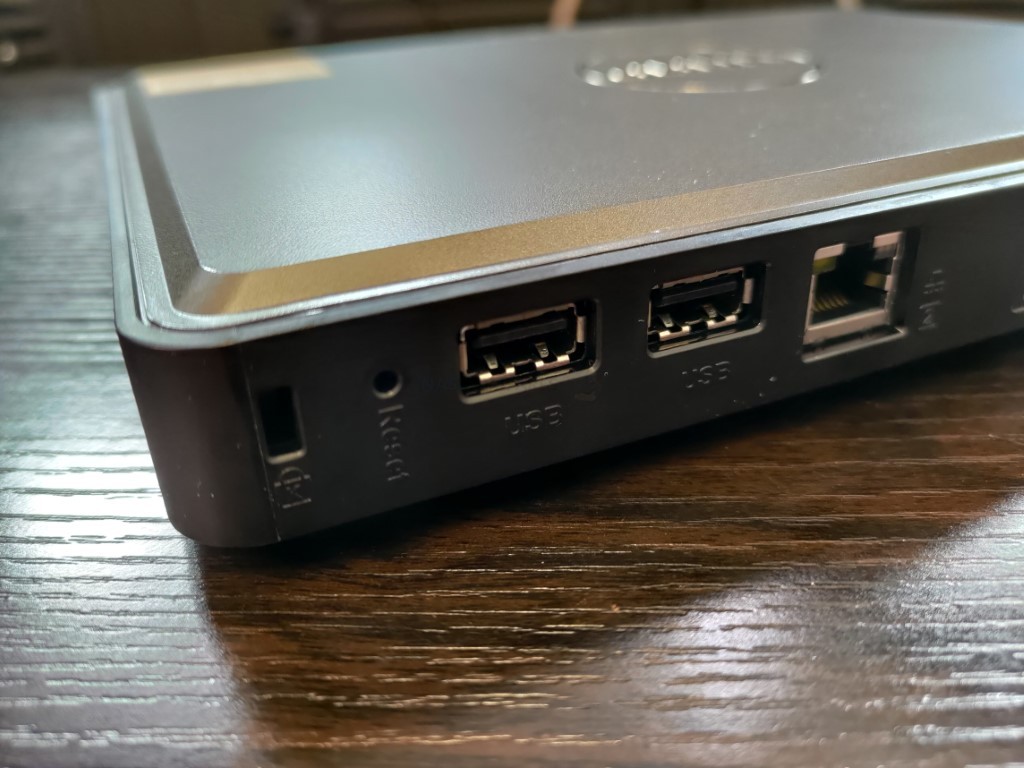
Overall, as long as you understand how QNAP have had to work within a given scope of the CPU and it’s PCI lanes, most of the TBS-464 NAS’ ports and connections make a lot of sense. But let’s take a look at the internal hardware of the TBS-464 and see how the system intended to deploy those super-fast NVMe SSDs.
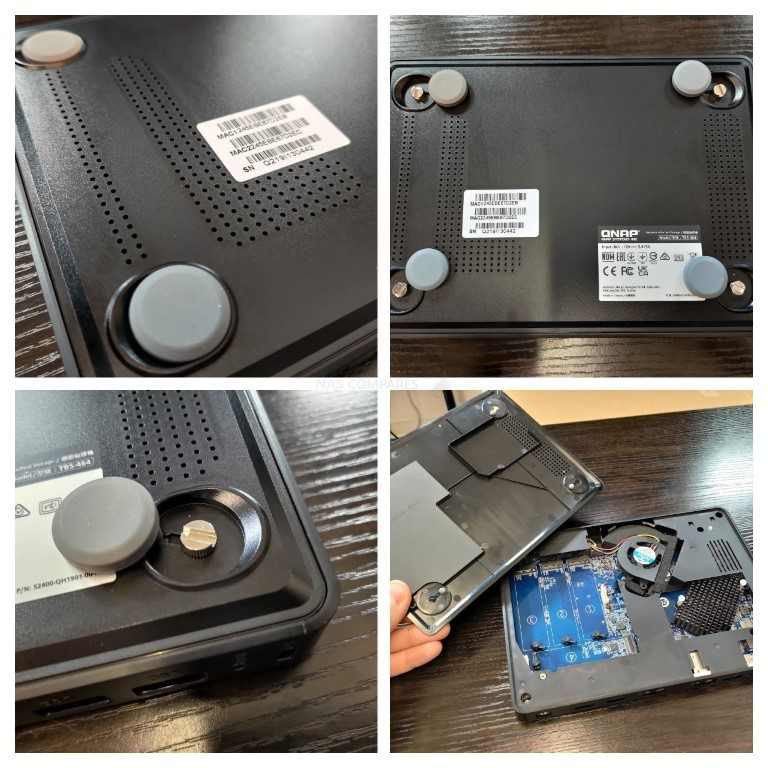
QNAP TBS-464 NVMe SSD NAS Review – Internal Hardware
Removing the base plate of the TBS-464 reveals an internal framework that looks much less like a typical NAS and much more like a prosumer laptop. The components are clearly separated into individual sections, as well as the components also featuring an additional cover layer that helps the air flow through the system and over the components that need it most.
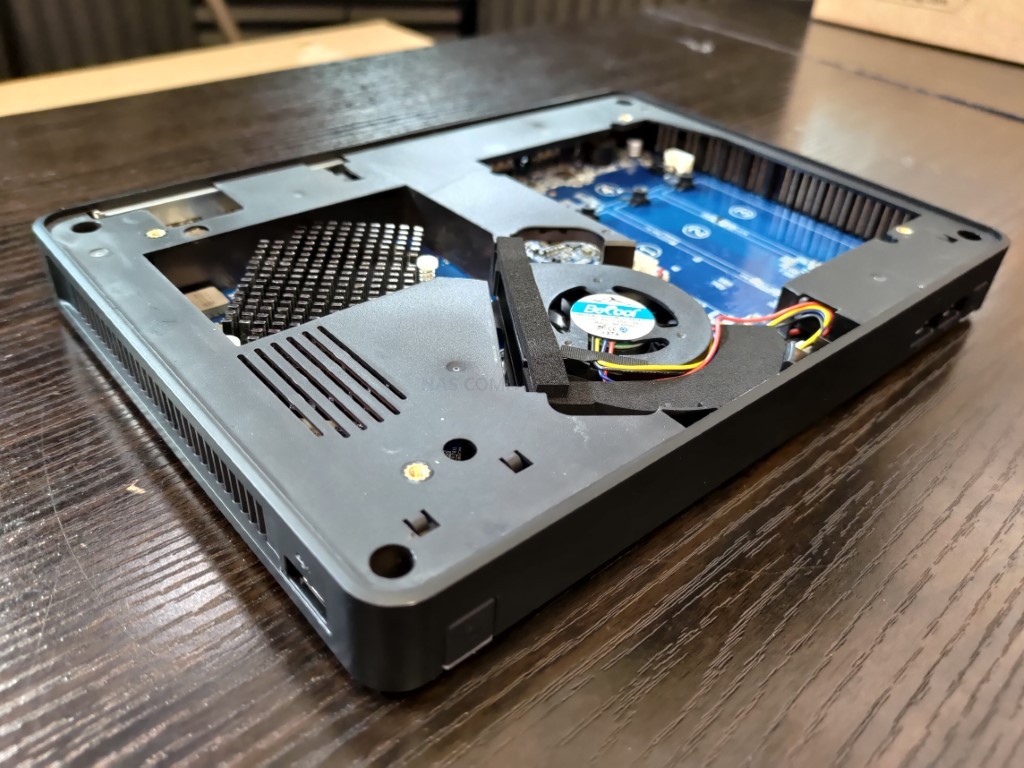
The four NVMe M.2 SSD ports are arranged in a deeper cavity and a 3+1 physical configuration. Each has ample room for single and double-sided SSDs (as well as the included thermal pads and heatsinks) and the system can be used with as little as a single NVMe SSD (allowing you to add drives later as your capacity or redundancy requirements grow). These bays are located directly next to the first side vent panel and the single internal fan is pulling air through this vent and over the SSDs. As long as you attach the thermal pads and heatsinks to dissipate (draw) the heat from the SSDs, the air will cool them down and then push air out the other side.
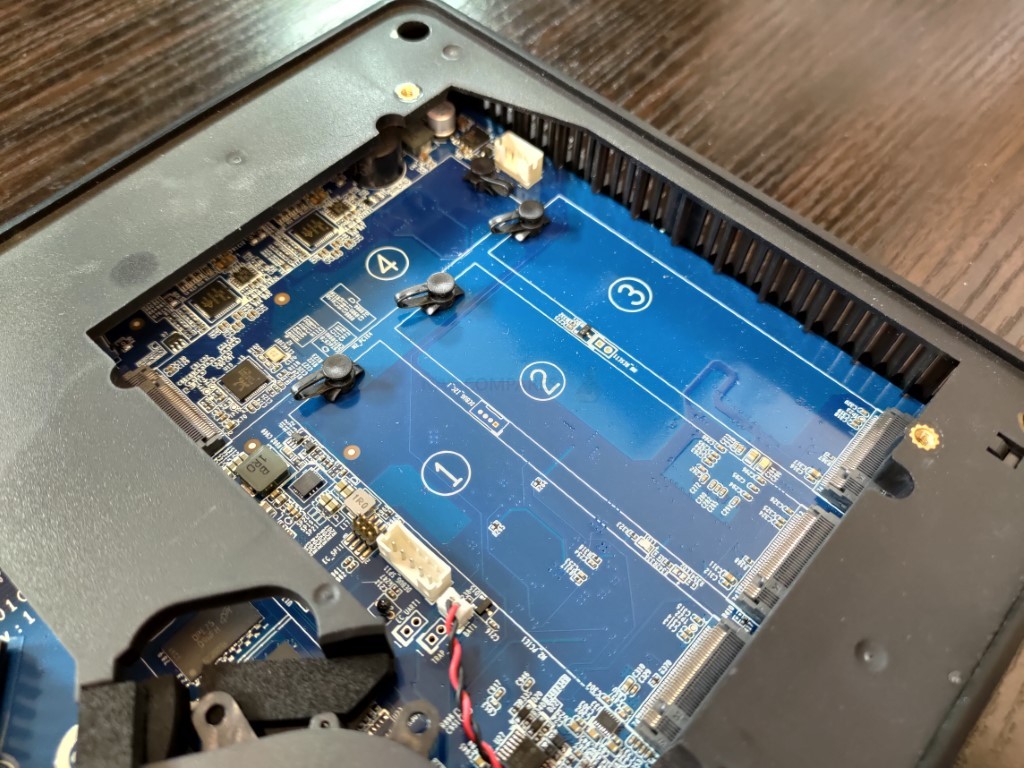
Revisiting the subject of CPU PCI lanes leads to one part of the TBS-464 architecture that may disappoint. Each of the M.2 NVMe SSD slots is PCIe Gen 3 x2 in bandwidth. This means that each slot can provide a potential 2,000MB/s of performance. However, the majority of modern PCIe Gen 3 SSDs arrive in Gen 3×4, normally hitting the 3,000-3,400MB/s performance mark. Although the TBS-464 is pretty much the ONLY desktop NVMe SSD NAS in the world, it is still a shame that each slot has this unavoidable bottleneck internally. This is still very, VERY high performance internally however that hugely dwarfs many other NAS of similar CPU architecture and something taht you would need a much larger arrangement of STA HDD or SSD to match.
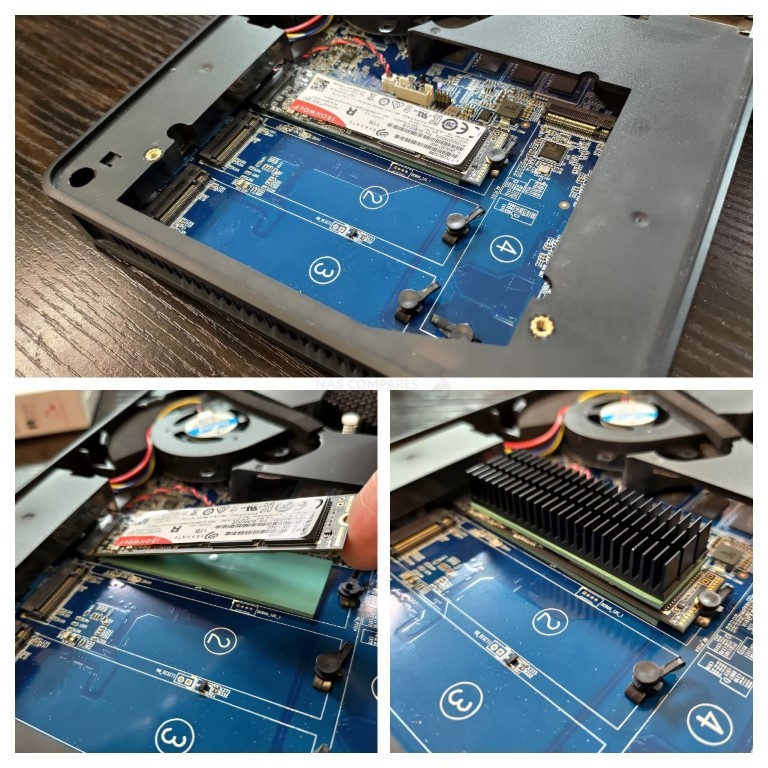
That internal fan. once it has drawn air over the NVMe SSD media+heatsinks, will theN push air out over the CPU heatsink and out the other vent. It does this with very little ambient noise (as long as you utilize appropriate heatsink and pad installation) and ensures that this little NAS makes little to no impact on your hardware environment.
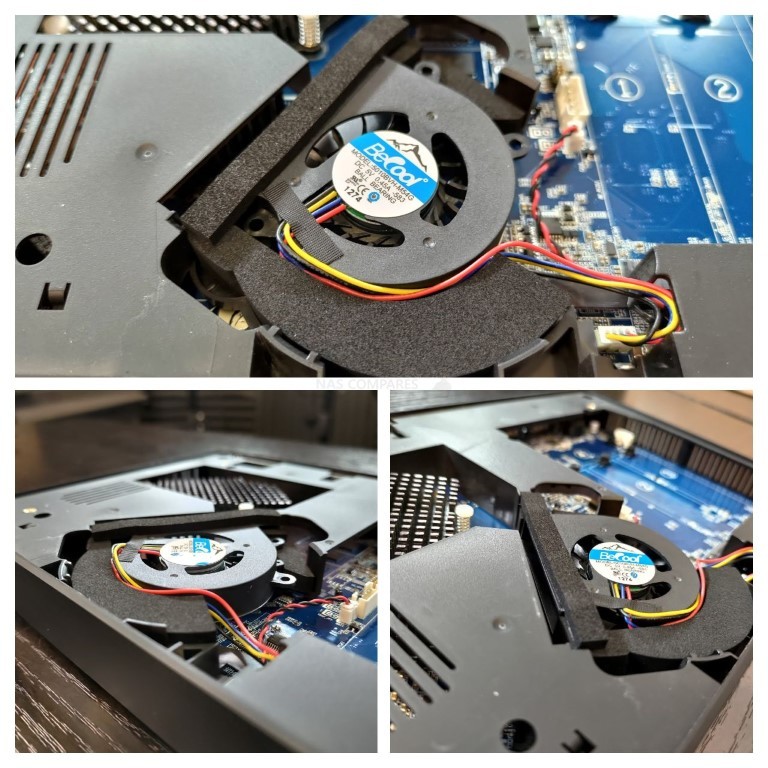
The TBS-464 uses a negative pressure cooling system, with large vents on either side of the compact chassis to pull air in one way over the storage media, then out through the other side. Below is a graphic:
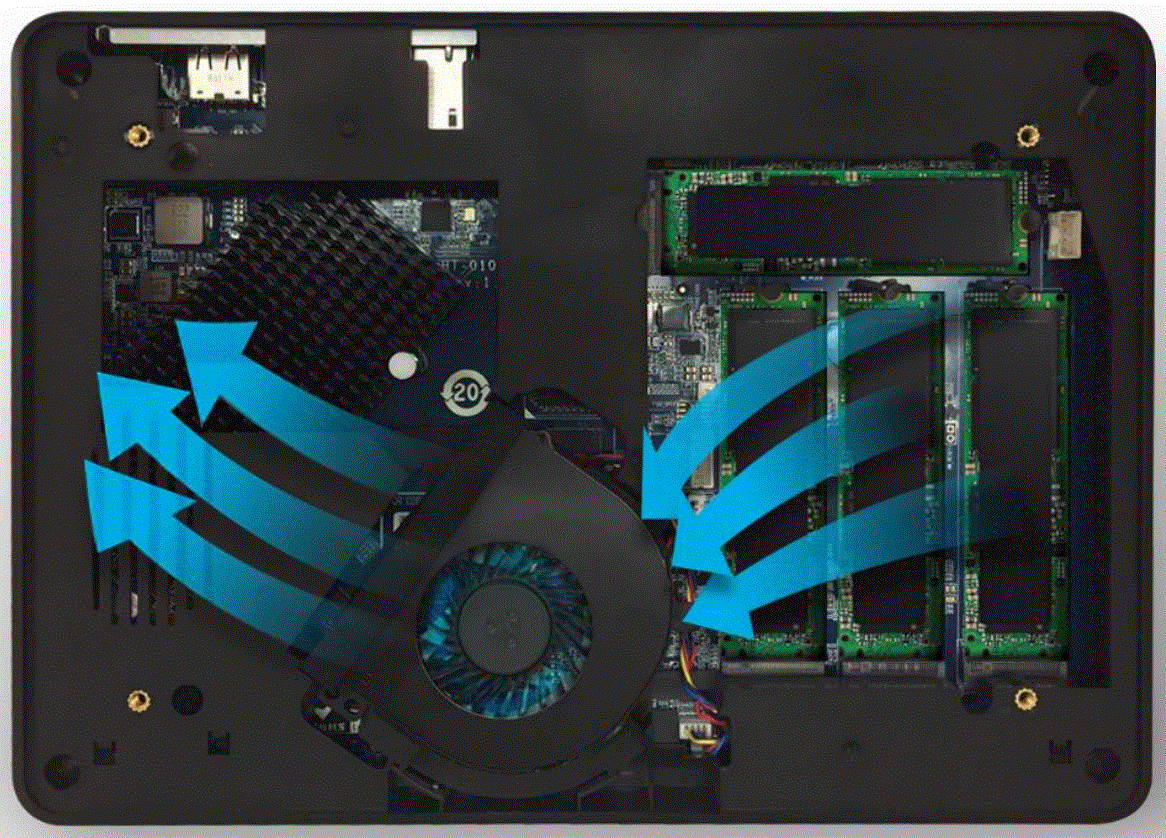
The CPU and memory used in the TBS-464 are also of a good standard for a 2021/2022 Prosumer/SMB NAS release. Alongside an Intel Celeron CPU, it also arrives with 8GB of DDR4 2400Mhz memory (which sadly cannot be upgraded to the maximum 16GB supported by the CPU). 8GB is still a very decent about of base-level memory on this NAS. But the CPU is where I really want to focus.
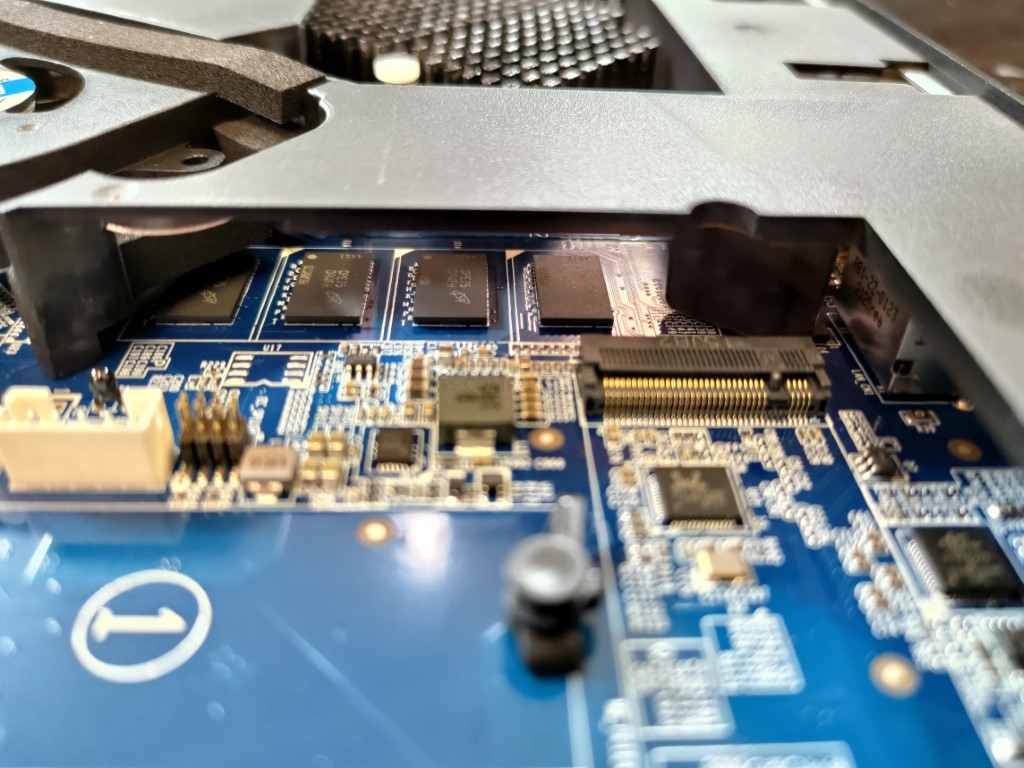
The Celeron series is one that is generally refreshed every 18-24months by Intel on their production line. However, because of semi-conductor shortages and the effects of the pandemic in 2020/2021 on production lines, the result is that the Intel Celeron series most recent revisions have been remarkably erratic and the result is that the Celeron CPU of the newest TS-x64 series from QNAP actually spans three different (but VERY similar CPUs).
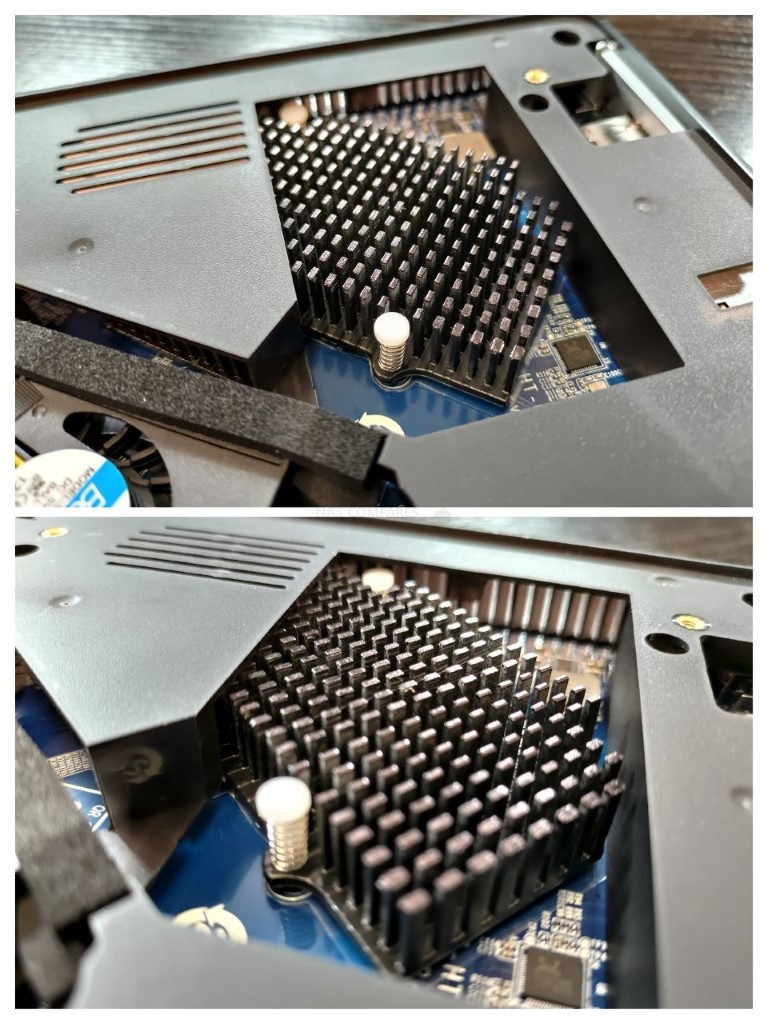
In the case of the TBS-464, it arrives with the Intel N5105 or N5095. Both are 2.0Ghz in architecture that can be boosted to 2.99Ghz by the system when needed, as well as supporting on-broad graphics (so the support of transcoding and handling graphical data like 4K media and 3D images) to the same degree, AES-NI inline encryption and a great floating point. Aside from very minor differences around encoding/decoding and a slightly raised TDP (so, the amount of heat vs power draw) on the N5095, they are pretty much identical. Both are a nice jump up from the 2017/18 generation Intel Celeron J4115 that is used in the previous generation and at this price point, I am happy with this chip. Expect Plex testing and Virtual Machine testing soon.

Overall, the internal architecture of the QNAP TBS-464 NAS at it’s £499 RRP (579 Euros), which will almost certainly be lower on most e-retailers, seems a reasonable price for the architecture here. Let’s talk a little bit about the software included with the TBS-464, known as QTS 5.
QNAP TBS-464 NVMe SSD NAS Review – Software & Services
Alongside the hardware of the TBS-464 NAS, you also receive the complete software and services package of QNAP QTS (currently in version 5.0). This is a complete operating system. similar in design and presentation to Android OS, it runs hundreds of applications, services and functions, as well as arriving with many mobile and desktop client applications that allow you to interact with the data on your NAS in a much more tailored way. Alongside this, the QNAP QTS software on the TBS-464 also includes a few extra SSD tools for anti-wearing on the SSDs, better SSD profiling and even options to separate the media into storage, caching or tiered storage where appropriate. The performance and services of QTS have been covered many times on this channel, so reviewing it’s individual performance on the TBS-464 NAS is a difficult task, as we have to look at two key things. Is QTS a good software platform and is QTS 5.0 a substantial update on QTS 4.5? On the first score, I can comfortably say that QNAP NAS software and services have truly come into their own and the balancing act of supplying the end-user with the flexibility to use the system ‘their way’, whilst still keeping it user friendly is the best it has ever been. Is it perfect, no. In its efforts to make itself customizable in every way possible, QTS develops an inadvertent learning curve that may catch some novice users unaware. Likewise, although QTS 5 has done a lot of work on its presentation of information and notifications, there is still the odd moment of ‘TMI’ when switching between services on the fly. QNAP’s NAS software is still easily one of the most adaptable in the market right now and allows users to have a truly unique storage environment if they choose and although not quite as user-friendly as Synology DSM, it counters this by being fantastically flexibly by comparison (from file/folder structure to 3rd party services support and connectivity). In order to see the extent of the latest version of QNAP TS 5.0M use the links below to the written review and video below released in late 2021:
| FULL Written QNAP QTS 5 Review | FULL Video Review of QNAP QTS 5 |
 |
Tests of the QNAP TBS-464 on how it performs as a Plex Media Server, host for Virtual Machines and more will be conducted shortly over on NASCompares YouTube channel. I recommend visiting there to learn more. Below is the video review for the QNAP TBS-464 NAS

QNAP TBS-464 NVMe SSD NAS Review – Conclusion & Verdict
The QNAP TBS-464 NVMe SSD NAS is a genuinely groundbreaking and unique piece of kit that is slightly hampered by its own price tag! Easily the most compact NAS currently available from this (and indeed almost any other) brand, it brings the majority of NAS software, services and features that buyers want in a NAS that shifts focus to SSD storage media and does it whilst maintaining an incredibly small footprint. The appeal of a RAID 5, NVMe powered NAS for your data, when the price of such media (in Gen 3 at least) becomes significantly more affordable is also a smart move. As a first physical reveal of QNAP’s planned X64 and X62 series, it hits all the right notes for me and as long as you understand that keeping this device Prosumer (whilst not tiptoeing into the enterprise) means that occasional hardware scaling is required, it’s a great piece of kit. A unique joy to play with.
| PROs of the QNAP TBS-464 NAS | CONs of the QNAP TBS-464 NAS |
| World’s First NVMe SSD Desktop NAS (at least as far I can find!)
VERY quiet, even with the fan on internally Newest Gen Intel Celeron CPU available on NAS right now 2x 2.5GbE and 4K 60FPS are always welcome Numerous considerations included/visible for heat dissipation and Anti-wear VERY compact deployment 8GB DDR4 Memory included by default Four NVMes in a RAID 5 = Good speed and Performance QTS 5 has more 1st Party applications and services than any previous version |
The lack of 10GbE from the TBS-453DX is a shame (PCI Lane related)
The NVMe SSD Bays are PCIe Gen 3 x2 (PCI Lane related) Memory cannot physically be upgraded beyond 8GB
|
🔒 Join Inner Circle
Get an alert every time something gets added to this specific article!
This description contains links to Amazon. These links will take you to some of the products mentioned in today's content. As an Amazon Associate, I earn from qualifying purchases. Visit the NASCompares Deal Finder to find the best place to buy this device in your region, based on Service, Support and Reputation - Just Search for your NAS Drive in the Box Below
Need Advice on Data Storage from an Expert?
Finally, for free advice about your setup, just leave a message in the comments below here at NASCompares.com and we will get back to you. Need Help?
Where possible (and where appropriate) please provide as much information about your requirements, as then I can arrange the best answer and solution to your needs. Do not worry about your e-mail address being required, it will NOT be used in a mailing list and will NOT be used in any way other than to respond to your enquiry.
Need Help?
Where possible (and where appropriate) please provide as much information about your requirements, as then I can arrange the best answer and solution to your needs. Do not worry about your e-mail address being required, it will NOT be used in a mailing list and will NOT be used in any way other than to respond to your enquiry.

|
 |
Beelink ME Pro NAS Revealed
Best SOLID STORAGE NAS of 2025
Should You Worry About the NanoKVM Hidden Microphone?
Best Cheap NAS of 2025
Minisforum MS-02 Ultra - WHO IS THIS FOR??? (The First 48HRs)
Why People Use TrueNAS, UnRAID and Proxmox to Turnkey NAS (Synology, QNAP, etc)
Access content via Patreon or KO-FI





Discover more from NAS Compares
Subscribe to get the latest posts sent to your email.


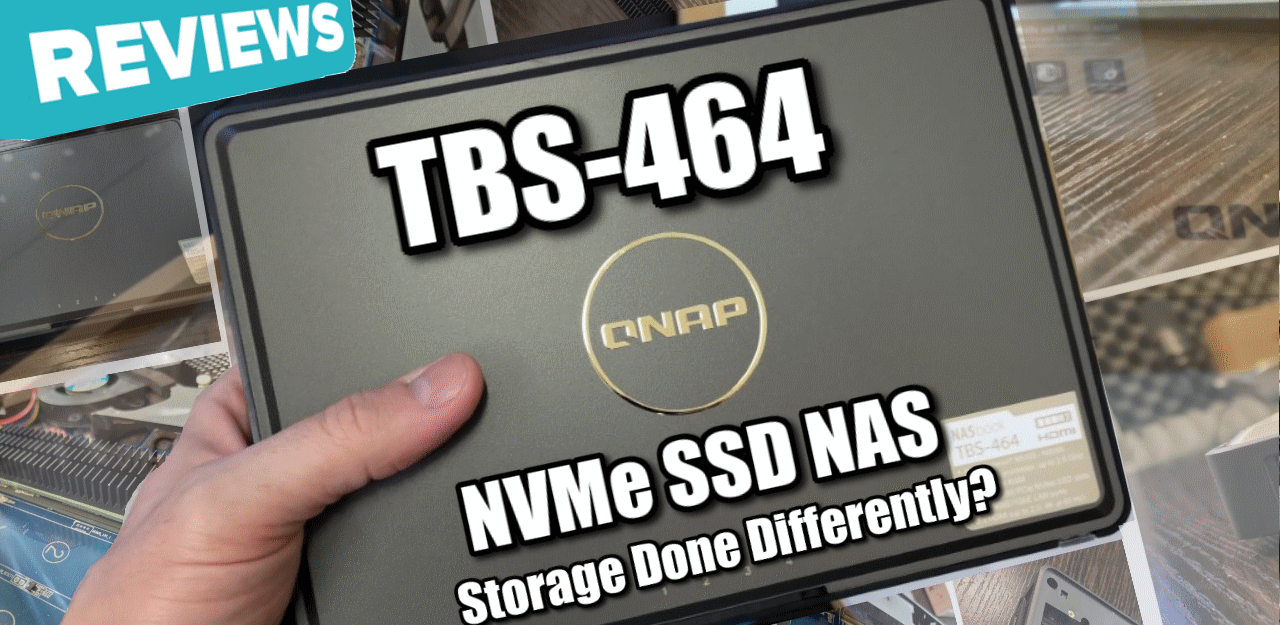




This video must have taken a long time to record and edit. Thanks, it helped me lot.
REPLY ON YOUTUBE
Hi there, thanks for the great video! I know this topic is about six years old, but I’m curious—have you ever managed to enable HDMI output passthrough for your Windows 11 VM on the TS-464? Right now I’m stuck with the default QXL 2.0 output, but I’d love to pass the VM’s graphics straight through to the NAS’s HDMI port. Do you know if that’s possible
REPLY ON YOUTUBE
Best you sends that little puppy to me. 🙂
REPLY ON YOUTUBE
Best you sends that little puppy to me. 🙂
REPLY ON YOUTUBE
Best you sends that little puppy to me. 🙂
REPLY ON YOUTUBE
Could I run 2 video editors off this via 2.5gbe? im looking for something small that can be taken out in the field that allows two editors to work off 8tb of footage.
REPLY ON YOUTUBE
???? seagulls
REPLY ON YOUTUBE
Thanks for the review. The TBS 464 was on my wishlist for a long time but regarding the price, the non expendable memory is a no-go. Upgraded my TS-264 to 32GB and its running awesome.
REPLY ON YOUTUBE
which m2 do you recommend? 🙂
REPLY ON YOUTUBE
so good in fact that there’s litterally nowhere to buy in in Europe, so nice 🙂
REPLY ON YOUTUBE
WTF soldered 8GB ram?! No upgrade possible?!
REPLY ON YOUTUBE
Hi, in addition to complimenting you on your truly excellent channel, I would like to ask you if this model manages a Web Server within its system, as I would like to manage web pages. Thank you
REPLY ON YOUTUBE
Yikes. Another example of putting a 1,000 hp engine in a car and hooking it up to a transmission that can do 200 ft/lbs torque max. Why do these companies do this to us? It really does seem like they’re just trying to rip people off by selling something that sounds better than it is.
REPLY ON YOUTUBE
Why did QNAP stop manufacturing this?
REPLY ON YOUTUBE
I will wait for the TBS-574X NAS
REPLY ON YOUTUBE
Thanks for the great review!
REPLY ON YOUTUBE
slow CPU.. shame
REPLY ON YOUTUBE
Qnap licensing are going to be their killer. They should at least make it free for home use.
REPLY ON YOUTUBE
0:20 that power brick thou ???????????? what are they all thinking ?! Why can’t they just include that in the case ?! It is horrible to have things dangling around the house like that. 6:26 … “65W” there are 65W USB-C adapters around, would have been nice to power it by USB-C.
REPLY ON YOUTUBE
For single-sided SSDs the manual shows to use 2 thermal pads together on the system board under the SSD and then the heatsink placed directly on top of the SSD. This is shown in both the manual and quick start guide. So the manufacturer are saying to apply both pads underneath. (and just one underneath for double-sided) Any thoughts?
REPLY ON YOUTUBE
Tempted to just build my own NVMe NAS, at least then I could use the system for more than just a NAS. Problem is finding an ITX board with numerous M.2 slots that supports a low power CPU architecture, best I could find is high end ITX gaming boards with three M.2 slots.
REPLY ON YOUTUBE
Next time put some real world transfer speeds results.
REPLY ON YOUTUBE
first (video) result in google search for keywords; “nvme hard disk nas server”, I learned about gen1/2/3/4/ speeds, as well as about possible Celeron bottleneck’s of CPU performance. Much obliged. This device is not for me, that is sure.
REPLY ON YOUTUBE
You’re so right. Not a lot of people are talking about it on YouTube. Bravo for putting a video like this together. Thank you mate.
REPLY ON YOUTUBE
Thank you for your great presentation. However my question is what is the max size of each NVMe SSDs I can install? 4TB – 8TB? In case possible 4 x NVMe SSDs 8TB can I reach a NAS in RAID of 32TB?
REPLY ON YOUTUBE
Should retitle this video to “How to use a lot of words to say very little”. Could have been a 4 minute vid.
REPLY ON YOUTUBE
Stop talking about things you are going to talk about, so annoying.
REPLY ON YOUTUBE
What’s the current best nvme has?, I need 25-50TB of redundant data storage
REPLY ON YOUTUBE
Are there any competitors to this now?
REPLY ON YOUTUBE
It has only 3 ssd slots? At the beginning you said 4.
REPLY ON YOUTUBE
“We’re consumers, who cares?”
Sad but honest comment
REPLY ON YOUTUBE
what is the pount of NVMe if there’s no 10GbE? just go with SATA m.2 drives or regular 2.5″ SATA. So stupid.
REPLY ON YOUTUBE
Well it would have been helpful mentioning in the beginning it is fan cooled, the beginning would not be that awkward “hey can you listen how quite is this rock” ….doooh…. yeah, ssds are 0dB /if you are not an unlucky SOB getting one with a coil whine/….otherwise interesting product, pity for the bottlenecks though….
REPLY ON YOUTUBE
This seems so unfocused, why so many usb2, why 2 hdmi, why nvme without 10gbe? What is the use case that utilizes all of this nvme?
REPLY ON YOUTUBE
Great Video! Should I purchase the SSD with custom integrated heatsink OR purchase without heatsink and use the QNAP supplied heatsink? I’m not concerned about the price with the custom heatsink I just want to know the best heatsink performance option. Also, do you know if the custom supplied heatsinks from Seagate are removable? If removable, that would give two options – either use custom heatsink or QNAP supplied. The SSD I want to purchase is the Seagate 4TB FireCuda 530 PCIe 4.0 x4 NVMe M.2 Internal SSD with Heatsink (MFR #ZP4000GM3A023)
REPLY ON YOUTUBE
these would make more sense if there were some much more affordable 4 TB NVME drives….
REPLY ON YOUTUBE
Have you tried to install custom OS on it? Clean debian or something?
REPLY ON YOUTUBE
thanks
REPLY ON YOUTUBE
Yup your right… not on board with 2.5gbe.. Especially for nvme. Would have liked one more m.2 for raid 5 🙂
REPLY ON YOUTUBE
Seagulls or seagate ?????????
REPLY ON YOUTUBE
low voice mate
REPLY ON YOUTUBE
What about stability between the two?
REPLY ON YOUTUBE
A channel just for nas? Sweeet!
REPLY ON YOUTUBE
Would be nice to have USB4 in this NVME NAS. Also missing 10Gbe. Probably to keep cost down. Maybe next version they will go all out, including the price.
REPLY ON YOUTUBE
I’m finding that the foam pad on the inside of the bottom panel – pushes quite firmly onto the top of the heatsink. Did you find the same thing – does this contact serve a purpose? Or do you think the foam should be removed?
Thanks for all your great videos – I am looking to upgrade my NAS and have settled on a Qnap TS-673A it will be my “home” NAS should I use QTS Hero ZFS or QTS 5 as my OP? Which is best? One of the main things I want to use is MyCloudLink (which I presume I can use on both OP)
REPLY ON YOUTUBE
As a new user you really make what was looking like a dive into the matrix, into something that I can actually folow. Thank you
REPLY ON YOUTUBE
The target market is Gaming with 4 drives in raid 0. This would give you over top speed and they can live with the limitations. Sure you lose space, and long term you will have to backup since ssds brake over time.
REPLY ON YOUTUBE
Thats exactly what I want
REPLY ON YOUTUBE
Great video Rob, thank you!
REPLY ON YOUTUBE
Guys, what would be a good 4tb SSD to use with this NAS? Any advice? Thanks!
REPLY ON YOUTUBE
where can I buy it?
REPLY ON YOUTUBE
Looking forward to see if this dethrones the DS920+ the all purpose home NAS
REPLY ON YOUTUBE
I am just tired of subpar products by all manufacturers. Its always been a case of “almost, but not quite” every time. Does not take away from this review though just frustration.
REPLY ON YOUTUBE
I would be instantly on this if 4TB+ NVMe drives were not expensive compared to HDDs
REPLY ON YOUTUBE
Bravo ???? you mentioned CPU lanes this time ????????????
REPLY ON YOUTUBE
great for a portable music studio…
REPLY ON YOUTUBE
Very useful video. ????Thanks! When you do the 2nd review please could you give a drive recommendation. Should it be used with NAS specific SSDs or will the most price effective consumer SSD be sufficient. Cheers!
REPLY ON YOUTUBE
Really cool device!! I just wished it had 10gbe.. is there anything similar on the market (the nvme design) with a bit higher specs of the cpu to achieve this? (doesn’t matter if it’s more experience)
REPLY ON YOUTUBE
So old 453DX is still faster throughput, isn’t it? Even if it might not max out the 10Gbe, SSD SATA is still faster than 2.5Gbe bottleneck right?
REPLY ON YOUTUBE
Cool. Thanks!
REPLY ON YOUTUBE
Can you please try compatibily of Sabrent Rocket m.2 SSD on this device ? Tnx
REPLY ON YOUTUBE
????????????????????
REPLY ON YOUTUBE
Dose qnap have some sort of hybrid raid ? That back up and save space.
REPLY ON YOUTUBE
Latest QTS 5 firmware update lost every user’s “home” folder when connecting via AFP in a finder window, only shared folders are shown. Even disabling and enabling home folders in users don’t take any effect. Only In browser UI the home folder is working properly.
REPLY ON YOUTUBE
I have TS253be and update to QTS 5.0 but NAS force me to initialize NAS (Reset NAS set up)
My raid was gone (Raid 1) while I Initialized NAS to start 5.0 and I try to back up my data to external hdd
but my 2nd disk was gone while back up I can recovery data 70% (Lost forever 30%) T.T
Do you have problem to upgrade like me?
REPLY ON YOUTUBE
Do you have an ETA for full release QuTS Hero 5.0?
REPLY ON YOUTUBE
I had to roll back.
5.0.0. gave me two weird issues.
1. The fans went to 100% and stuck there, regardless of any setting or actual system temp.
2. (And this one is really weird) IR remote button pushes would be registered twice, but only around 25-33% of the time.
I rolled back AND forward three times to check and double check these issues. I’m staying with 4.5.x until I know 5.x.x has the bugs ironed out.
REPLY ON YOUTUBE
i have found the file permission are better but….. in my case the everyone group has no rights assigned to it when checking on qnap.not denied not ro or rw. when you create a user via qnap and assign rights via windows. somewhere along the line everyone has now changed to denied access…..simply just remove anyone from the resource…but not the right way?
REPLY ON YOUTUBE
FULL Written Review of QNAP QTS 5 – https://nascompares.com/2021/10/08/qnap-qts-5-0-nas-software-review-worth-your-data/
01:50 – Disclaimers & Review Considerations
05:25 – Start – QTS Change of Focus
07:00 – QTS 5 vs QTS 4.5 GUI, Design, The Good, the Bad & the Awkward
10:13 – Responsiveness
10:44 – Things That Have Not Changed
11:30 – Security, Notifications & Control
14:25 – Control Panel
15:39 – Storage Manager
17:25 – Remote Mounting & Cloud Gateways
18:40 – File Management
20:30 – Multimedia Control & Sharing
27:00 – Storage Continued – Health & Checks
29:00 – Synchronization & Backup Tools
36:35 – Virtual Machines, Containers & Ubuntu VMs
41:05 – VMware, Hyper-V and SaaS Backups
43:14 – HDMI Services & HD Station
45:00 – Surveillance Tools & Services
49:00 – Licenses, Good & Bad
51:00 – QSirch, QFile, Teamviewer, Hybrid Mount and the Conclusion
REPLY ON YOUTUBE
Add chapters to this video
REPLY ON YOUTUBE
I have a TVS 873e when i seach for the upgrade to QTS 5 on the QNAP site it is not showing it for me. the highest firmware is 4,5,4 1800 am i not able to run V5?
REPLY ON YOUTUBE
Why the full release of QTS 5.0 is not arrived yet on TS-X53D series ?
REPLY ON YOUTUBE
awesome, perfect video as always; you’re the best source for nas – especially on qnap, i would say. Possessor of the – NOWADAYS pretty old – ts231+P and i still use it as my daily driver; with the new qts 5 now, seems even more faster
REPLY ON YOUTUBE
That robot reminds me of the old MS office “clippy”… Luckily he doesn’t ask “it appears you are trying to…” ????
REPLY ON YOUTUBE
That robot in the corner…. Reminds me of clippy… kill it with fire!
REPLY ON YOUTUBE
How did you get this installed on a TVS-872X? I am trying to get it on my TVS-872XT and this model is not officially supported on this initial 5.0 release.
REPLY ON YOUTUBE
First! Always love the content!
REPLY ON YOUTUBE